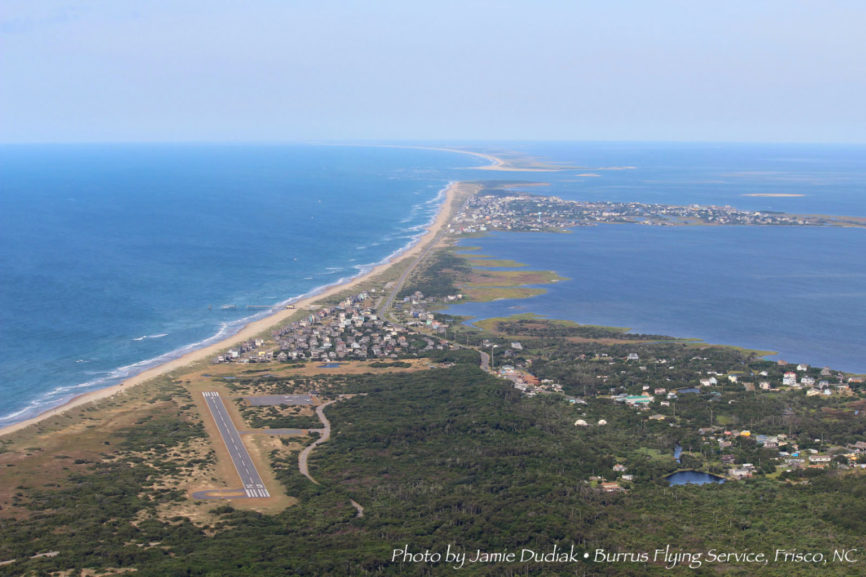Two US battleships, the USS New Jersey and the USS Virginia, rest 300’ beneath the waters of the Atlantic. About 16 miles from Cape Hatteras, they were sunk by friendly fire in a deliberate attempt to prove the potency of air power.
Their fate and how the oddly named Billy Mitchell Airport five miles east of Hatteras Village in Frisco came to be a part of the Outer Banks are bits of the same story.

Brigadier General Billy Mitchell is generally considered the father of the US Air Force. Years before anyone was advocating for air power, or even considered aircraft as potentially decisive on the battlefield, Mitchell was a lone voice in the wilderness.
Following WWI, he maintained that every ship in the US Navy was vulnerable to air attack. The Navy brass and military leaders, in general, were skeptical.
In 1921 aircraft under Mitchell’s command sank the supposedly unsinkable Ostfriesland, a surplus German battleship seized from Germany at the close of the war. The ship was sunk off the Virginia coast.
The demonstration was—and actually still is—somewhat controversial. Military leaders wanted Mitchell to bomb the ship in a series of attacks, allowing experts to examine damage between attacks.
Mitchell ordered his pilots to throw all their bombs at the ship at once, sinking it in 20 minutes.
Because the results were considered insufficient to prove or disprove Mitchell’s theories, a second test was established, this time off Diamond Shoals.
The two ships selected, the New Jersey and Virginia were sister ships commissioned in 1906. Under the terms of the WWI armistice, they were considered surplus weaponry.
The test that the Mitchell devised this time was far more ambitious than the Ostrriesland. It was his intent to prove that naval ships were susceptible to long range bombing attacks.
On September 5, 1923, bombers took off from Langley Airfield, 175 miles from the ships. As military brass watched from another ship, the first of Mitchell’s bombers arrived, dropping bombs from 10,000’, followed by a second run from 6000’. Then aircraft from a temporary airfield constructed near Buxton finished the bombing run.
Although naval command continued to insist air power could not sink a ship under steam that was protecting itself, the Cape Hatteras bombing runs were significant for a number of reasons.
Mitchell was able to effectively demonstrate that long range bombing was feasible. He had been maintaining for some time that the best defense of the American borders were bombers that could intercept any foreign fleet well before they came close to our shoreline.
It was also the first time a bombsight was used. Although primitive compared to the designs that followed, the fact that four of the bombs dropped from 10,000’ either struck their target or were near misses, proved they were effective.
The official report, however, downplayed the effectiveness of the demonstration. Mitchell, incensed, battled his superior officers in the Army—which had acquiesced to the report—and Navy who issued the report.
In 1925 he was transferred to San Antonio, Texas, as air officer to a ground forces corps. The reassignment was short-lived.
In September of that year, the naval airship Shenandoah crashed in bad weather with a loss of 14 lives. Mitchell issued a public statement accusing the War and Navy Departments of “incompetence, criminal negligence, and almost treasonable administration” when it came to aviation.
He went on to write, “Brave airmen are being sent to their deaths by armchair admirals who don’t care about air safety.”
His views may or may not have been accurate, but they were certainly insubordinate, Brought to Washington, DC for a court martial, he was found guilty and sentenced to five years of suspended service at half pay.
Mitchell resigned his commission at that time.
Billy Mitchell Airport is a 3002’ runway, owned by the National Park Service but managed by NCDOT Department of Aviation. It is close to the location of the temporary field.
